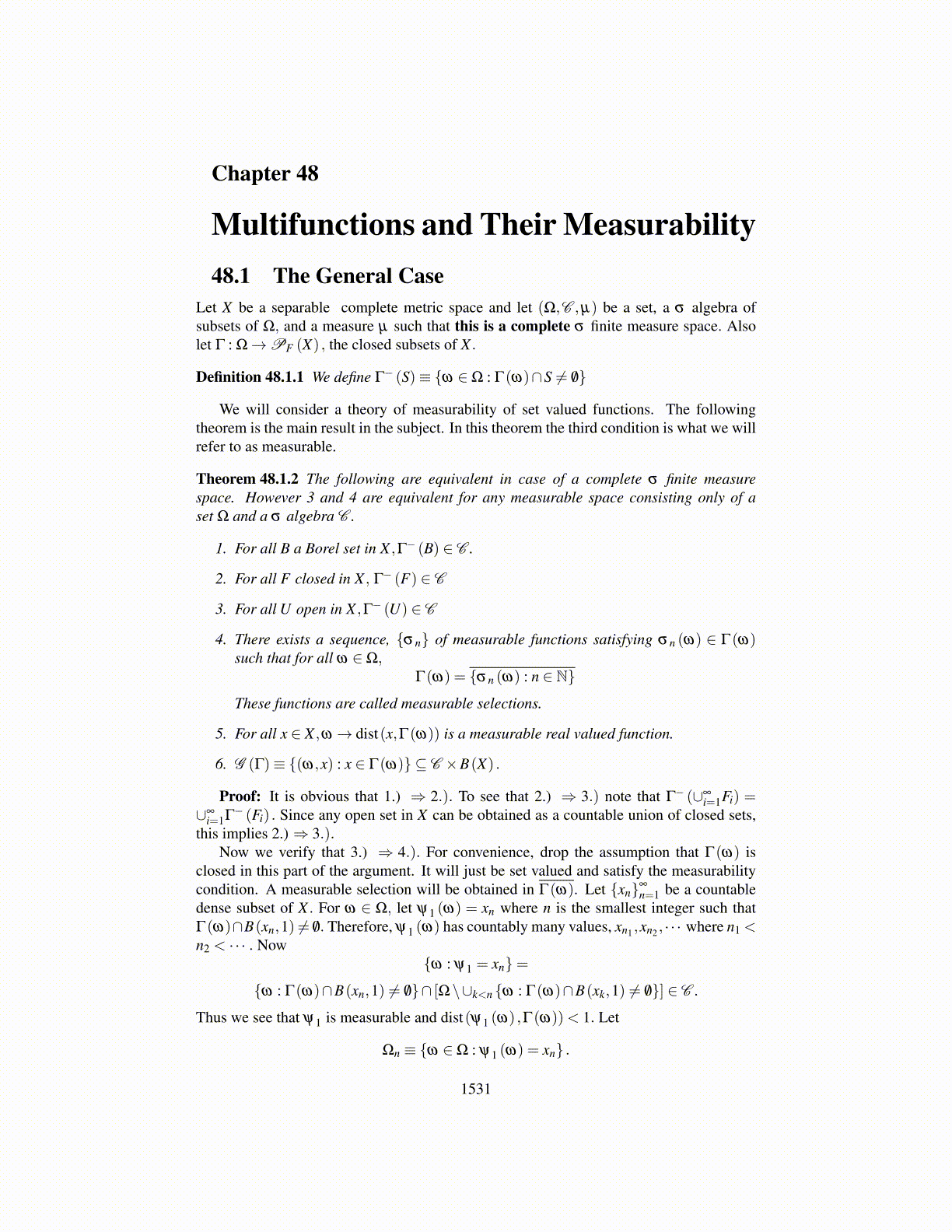
1531
Theorem 47.0.19 Let (Ω,Σ) be a measure space and let G∈ Σ̂×B(X) where X is a Suslinspace. Then
projΩ (G) ∈ Σ̂.
Proof: By the previous lemma, G ∈ Σ0×B(X) where Σ0 is countably generated. If(Ω,Σ0) were separable, we could then apply Lemma 47.0.17 and be done. Unfortunately,we don’t know Σ0 separates the points of Ω. Therefore, we define an equivalence class onthe points of Ω as follows. We say ω ∽ ω1 if and only if XA (ω) =XA (ω1) for all A∈ Σ0.Now the nice thing to notice about this equivalence relation is that if ω ∈ A ∈ Σ0, and ifω ∽ ω1, then 1 = XA (ω) = XA (ω1) implying ω1 ∈ A also. Therefore, every set of Σ0is the union of equivalence classes. It follows that for A ∈ Σ0, and π the map given byπω ≡ [ω] where [ω] is the equivalence class determined by ω,
π (A)∩π (Ω\A) = /0.
Suppose now that Hn ∈ Σ0×B(X). If ([ω] ,x) ∈ ∩∞n=1π× idX (Hn) , then for each n,
([w] ,x) = (πwn,x)
for some (ωn,x) ∈ Hn. But this implies ω ∽ ωn and so from the above observation thatthe sets of Σ0 are unions of equivalence classes, it follows that (ω,x) ∈ Hn. Therefore,(ω,x) ∈ ∩∞
n=1Hn and so ([ω] ,x) = π× idX (ω,x) where (ω,x) ∈ ∩∞n=1Hn . This shows that
π× idX (∩∞n=1Hn)⊇ ∩∞
n=1π× idX (Hn) .
In fact these two sets are equal because the other inclusion is obvious. We will denote byΩ1 the set of equivalence classes and Σ1 will be the subsets, S1, of Ω1 such that S1 ={[ω] : ω ∈ S ∈ Σ0} . Then (Ω1,Σ1) is clearly a measure space which is separable. Let
F ≡{
H ∈ Σ0×B(X) : π× idX (H) ,π× idX(HC) ∈ Σ1×B(X)
}.
We see that the measurable rectangles, A×B where A ∈ Σ0 and B ∈ B(X) are in F , thatfrom the above observation on countable intersections, F is closed with respect to count-able unions and closed with respect to complements. Therefore, F is a σ algebra and soF = Σ0×B(X) . By Lemma 47.0.14 (Ω1,Σ1) is isomorphic to (E,B(E)) where E is asubspace of {0,1}N . Denoting the isomorphism by h, it follows as in Lemma 47.0.17 thath× idX maps Σ1×B(X) to B(E)×B(X) . Therefore, we see f ≡ h◦π is a mapping fromΩ to E which has the property that f × idX maps Σ0×B(X) to B(E)×B(X) . Now fromthe proof of Lemma 47.0.17 starting with the claim, we see that G ∈ Σ̂0. However, if µ is a
finite measure on Σ̂, then(
Σ̂
)µ
= Σµ and so Σ̂0 ⊆(̂
Σ̂
)⊆ Σ̂. This proves the theorem.